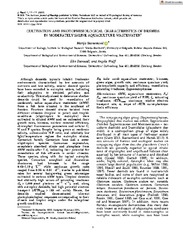Приказ основних података о документу
Cultivation and Photophysiological Characteristics of Desmids in Moderately Saline Aquaculture Wastewater
| dc.creator | Stamenković, Marija | |
| dc.creator | Steinwall, Elin | |
| dc.creator | Wulff, Angela | |
| dc.creator | Henley, W. | |
| dc.date.accessioned | 2021-04-14T09:31:14Z | |
| dc.date.available | 2021-04-14T09:31:14Z | |
| dc.date.issued | 2021 | |
| dc.identifier.issn | 0022-3646 | |
| dc.identifier.uri | https://onlinelibrary.wiley.com/doi/10.1111/jpy.13150 | |
| dc.identifier.uri | https://radar.ibiss.bg.ac.rs/handle/123456789/4189 | |
| dc.description.abstract | Although desmids typically inhabit freshwater environments characterized by low amounts of nutrients and low salinity, several desmid species have been recorded in eutrophic waters, indicating their adaptation to elevated pollution and conductivity. This study aimed to determine whether desmids could be used for remediation of moderately saline aquaculture wastewater (AWW) from a fish farm situated in the southeast of Sweden. Fourteen desmid strains isolated from different climates (tropical to polar) and trophic conditions (oligotrophic to eutrophic) were cultivated in diluted AWW and we estimated their growth rates, biomass, nutrient removal efficiency, chlorophyll fluorescence parameters and cellular C, N and P quotas. Despite being grown at moderate salinity, unfavourable N:P ratio, and relatively low light/temperature regime the eutrophic strains, Cosmarium humile, Cosmarium laeve and a meso-oligotrophic species Cosmarium impressulum, completely absorbed nitrate and phosphate from AWW media after 7 d, indicating their potential for remediation of fish effluents in colder climates. These species, along with the typical eutrophic species, Cosmarium meneghinii and Staurastrum chaetoceras, had biomass in the range 0.45-1.19 g · L −1 while maximum growth rates ranged from 0.36 to 0.51 · d −1 , similar to published rates for several fast-growing green microalgae cultivated in various AWW types. Tropical desmids had distinctly high values of saturating irradiance (I k > 1,000 µmol photons · m −2 · s −1), and, along with eutrophic desmids, had high potential electron transport (rETR max > 155 rel. units). Hence, the desmids studied demonstrated inherent photophysiological responses corresponding to their climate and trophic origin under the suboptimal growth conditions. | |
| dc.publisher | Wiley | |
| dc.relation | info:eu-repo/grantAgreement/MESTD/inst-2020/200007/RS// | |
| dc.relation | Swedish Institute provided to M. Stamenković (SI No. 02390/2016) | |
| dc.rights | openAccess | |
| dc.rights.uri | https://creativecommons.org/licenses/by/4.0/ | |
| dc.source | Journal of Phycology | |
| dc.subject | Key index words: aquaculture wastewater | |
| dc.subject | Zygnematophyceae | |
| dc.subject | biomass | |
| dc.subject | green algae | |
| dc.subject | growth rate | |
| dc.subject | maximum quantum yield | |
| dc.subject | photosynthetic capacity and efficiency | |
| dc.subject | remediation | |
| dc.subject | saturating irradiance | |
| dc.title | Cultivation and Photophysiological Characteristics of Desmids in Moderately Saline Aquaculture Wastewater | |
| dc.type | article | en |
| dc.rights.license | BY | |
| dcterms.abstract | Стеинwалл, Елин; Wулфф, Aнгела; Стаменковиц́, Марија; Хенлеy, W.; | |
| dc.rights.holder | © 2021 The Authors. Journal of Phycology published by Wiley Periodicals LLC on behalf of Phycological Society of America. | |
| dc.citation.issue | 3 | |
| dc.citation.volume | 57 | |
| dc.identifier.doi | 10.1111/jpy.13150 | |
| dc.identifier.pmid | 33598949 | |
| dc.identifier.scopus | 2-s2.0-85103220622 | |
| dc.identifier.wos | 000633852200001 | |
| dc.citation.apa | Stamenković, M., Steinwall, E., & Wulff, A. (2021). Cultivation and Photophysiological Characteristics of Desmids in Moderately Saline Aquaculture Wastewater. Journal of Phycology, 57(3) 726-741. | |
| dc.citation.vancouver | Stamenković M, Steinwall E, Wulff A. Cultivation and Photophysiological Characteristics of Desmids in Moderately Saline Aquaculture Wastewater. Henley W, editor. J Phycol. 2021;57(3):726-41. | |
| dc.citation.spage | 726 | |
| dc.citation.epage | 741 | |
| dc.type.version | publishedVersion | |
| dc.identifier.fulltext | https://radar.ibiss.bg.ac.rs/bitstream/id/8347/jpy.13150.pdf | |
| dc.citation.rank | M21 |

